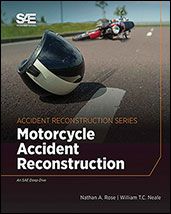Journal Article
Speed Analysis of Yawing Passenger Vehicles Following a Tire Tread Detachment
2019-04-02
2019-01-0418
This paper presents yaw testing of vehicles with tread removed from tires at various locations. A 2004 Chevrolet Malibu and a 2003 Ford Expedition were included in the test series. The vehicles were accelerated up to speed and a large steering input was made to induce yaw. Speed at the beginning of the tire mark evidence varied between 33 mph and 73 mph. Both vehicles were instrumented to record over the ground speed, steering angle, yaw angle and in some tests, wheel speeds. The tire marks on the roadway were surveyed and photographed. The Critical Speed Formula has long been used by accident reconstructionists for estimating a vehicle’s speed at the beginning of yaw tire marks. The method has been validated by previous researchers to calculate the speed of a vehicle with four intact tires. This research extends the Critical Speed Formula to include yawing vehicles following a tread detachment event.

